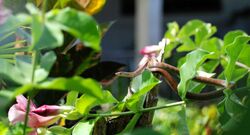Biology:Borikenophis portoricensis
| Borikenophis portoricensis | |
|---|---|

| |
| Scientific classification | |
| Domain: | Eukaryota |
| Kingdom: | Animalia |
| Phylum: | Chordata |
| Class: | Reptilia |
| Order: | Squamata |
| Suborder: | Serpentes |
| Family: | Colubridae |
| Genus: | Borikenophis |
| Species: | B. portoricensis
|
| Binomial name | |
| Borikenophis portoricensis (Reinhardt and Lütken, 1863)[1]
| |
| Synonyms[1] | |
|
Alsophis portoricensis Reinhardt and Lütken, 1863 | |
Borikenophis portoricensis[1] (Vernacular Spanish: Culebra Corredora;[2] Vernacular English: Puerto Rican racer[3]) is a snake endemic to Puerto Rico. It can grow to three feet long.
Range
The Puerto Rican Racer is endemic to the island of Puerto Rico.[4] It slinks around in the trees of the Toro Negro State Forest.[5] It has also been spotted at El Yunque National Forest.[6]
Appearance
Its body sports a solid brown color with each of his scales edged by a darker brown. The Puerto Rican racer also possesses a neck hood similar, but narrower, to that of a cobra which it exposes by raising the front quarters of their bodies off the ground in a manner similar to that genus. However, unlike the Naja snakes, B. portoricensis does not gratuitously exhibit this behavior as an intimidation tactic and generally employs it while engaging on offensive behavior after being provoked, which typically involves adopting the posture followed by an emboldened strike.[7]
Hunting habits
Like the Toro Negros's other various garden snakes, it is a daytime hunter.[8] It is capable of inflicting a venomous bite.[4] Once it captures its prey, B. portoricensis has a tendency of relocating it prior to feeding.[7] Although still susceptible to infection, it is more resistant to parasites than other local snakes, allowing it to survive exclusively on lizards.[7] The severity of its venom depends on the susceptibility of the victim, it is capable of fully paralyzing small reptiles and rodents rendering them helpless for consumption, but in humans its effects ranges from mild swelling to immobilization and severe numbness that may last up to a month.[7] No fatalities have been reported from the bite of a Puerto Rican racer.[7]
See also
- List of amphibians and reptiles of Puerto Rico
- Fauna of Puerto Rico
- List of endemic fauna of Puerto Rico
References
- ↑ 1.0 1.1 1.2 Uetz, Peter; Hallermann, Jakob. "Borikenophis portoricensis". http://reptile-database.reptarium.cz/species?genus=Borikenophis&species=portoricensis. Retrieved 11 September 2013.
- ↑ Volume 1: Land Cover, Vertebrate Species Distributions, and Land Stewardship. William A. Gould, Caryl Alarcón, Brick Fevold, Michael E. Jiménez, Sebastián Martinuzzi, Gary Potts, Maya Quiñones, Mariano Solórzano, and Eduardo Ventosa. The Puerto Rico Gap Analysis Project. (Publication Number: IITF-GTR-39) USDA. Forest Service. International Institute of Tropical Forestry. March 2008. Page 140. Retrieved 18 August 2013.
- ↑ 2007 Wildlife Facts - Puerto Rican Racer. USDA. Forest Service. "El Yunque National Forest." Retrieved 26 August 2013.
- ↑ 4.0 4.1 Is the Puerto Rican racer, Alsophis portoricensis, really harmless? A case report series. García-Gubern C., Bello R., Rivera V., Rocafort A., Colon-Rolon L., Acosta-Tapia H. (Department of Emergency Medicine, Hospital San Lucas, Ponce School of Medicine, Ponce, Puerto Rico.) 2010. Wilderness Medical Society. Published by Elsevier Inc. (Wilderness Environ Med. 2010 Dec; 21(4):353-6. doi: 10.1016/j.wem.2010.07.001. Epub 2010 Aug 5.) Retrieved 29 July 2013.
- ↑ Animals in the Toro Negro Forest. Amy M. Armstrong. Demand Media. Retrieved 30 July 2013.
- ↑ El Yunque National Forest: 2007 Wildlife Facts - Puerto Rican Racer. United States Department of Agriculture. Forest Service. Accessed 20 May 2019.
- ↑ 7.0 7.1 7.2 7.3 7.4 Snakes Of Puerto Rico. Larry Rodriguez-Fornaris. Chewy, Inc. 2018. Accessed 20 May 2019.
- ↑ Animals in the Toro Negro Forest. Amy M. Armstrong. Demand Media. Retrieved 30 July 2013.
Wikidata ☰ Q692225 entry


